Bio-mechanical principals of Tennis
By Peet van Schalkwyk
e-mail: PeetvanSchalkwyk@gmail.com Please let me know what you think of this page.
VERY IMPORTANT
One of the most important things in a tennis stroke is to play with a firm grip and a RELAXED WRIST. Try this for immediate improvement in your stroke making.
Introduction
Every young tennis player is interested in the secrets of the game of tennis – what makes you a champion? Top players usually give answers like: keep your eye on the ball, play in front of your body, play through the ball, keep the ball in play, relax, play percentage tennis, think positive, etc.
I have found that I return the best if I focus on the point of contact, that is where I will hit the ball, in front of my body. At the same time I keep my eyes on the ball, and forget about my body movements and positions. You can exercise the body movements during training sessions until your movements automatically come.
It's much like riding on a bike, focus on where you want to go and forget about your legs and hands and body movements.
One of the key things that plays a role in the game of tennis is the laws of nature, or in other words, the bio-mechanics of tennis. But this is only one of the many aspects of tennis that the successful player (on various levels) has to integrate into his/her game.
As a physicist and engineer as well as a keen tennis player, I am interested in the role of bio-mechanics in tennis and how it could improve my game of tennis. I analyzed the strokes of top players for many years, I have read a lot about tips from top-players but most importantly, over the years I tried many of these things myself.
Eventually a number of things crystallized out. I was amazed at how simple the answers of bio-mechanics are. And I was amazed on how the bio-mechanics match with the tips from top-payers and the ways they execute their strokes.
Here are a few bio-mechanical principals of tennis. Analyze your game by taking these principals into account and see what works for you.
Bio-mechanical principals of tennis
First a summary of the principals (there may be many more)
1. Use the speed of the oncoming ball by reflecting it with the racket.
2. To generate power, drive your hand right up to point of contact.
3. Play through the ball (the racket is an impact instrument).
4. Grip: Make sure your racket head is slanted slightly forward on impact for a topspin and slanted backwards for a backspin. The angle at which the racket head is slanted depends on your grip. Years ago kids were told to use the "handshake" grip. These days for a topspin ground stroke everybody move the hand more to the back of the handle.
5. The back-swing is vital for generating topspin or backspin of the ball (the racket behaves as a pendulum).
6. Whip the ball, especially with the service. Your wrist must be relaxed. That means that your hand already moves forward while the racket head still swings backwards.
7. Orientation of racket on impact (for control, the length axis of the racket must be as close as possible to be perpendicular to the plane of the eventual trajectory of the ball).
8. String tension is important. The strings behave as a trampoline for the ball.
9. Altitude.
10. Surface of court.
1. Reflecting the ball
The service and the volley represent two extreme shots in tennis. With the service you have to generate all the speed of the ball because the ball is stationary while with a volley you can use the speed of the ball by reflecting it. Ground strokes are a combination of reflecting the ball and generating power with the racket.
The service is much like strokes in the game of golf where the ball is also stationary and the player has to generate all the speed of the ball. The volley is like some shots in cricket where the strikers make use of the speed of the ball and simply reflect it.
2. Generating power
Generate speed of the racket head by driving with your hand up to the point of contact. If you concentrate on contacting the ball in front of the body, you will automatically generate power.
With the service it will help a lot if you bend the elbow and then stretch it while driving the hand towards the point of impact.
3. Racket as an impact instrument
Drive through the ball because the racket is basically an impact instrument with a “sweetspot”. If the ball makes contact with the racket at the sweetspot, there will be no shock in the hand and maximum power will be transferred to the ball.
The hand must grip firmly on the handle but the wrist must be relaxed.
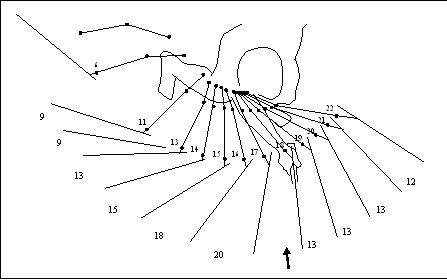
Click here to see animation of the above stroke
This is a frame for frame tracing of a film made by Plagenhoef in 1970.
In the diagram the positions of the shoulder, elbow and wrist are marked and numbered up to 22. The speed of the racket is shown in relative dimensions. The arrow shows the point of impact.
Take notice that the head of the racket looses speed after impact while speed of the wrist stays the same.
4. Grip
Make sure your racket head has the correct vertical angle at impact, which depends on your grip. To determine the grip for a specific shot, hold your racket and move it to the point of impact and have a look at the inclination of the racket head. The racket head should be slanted forwards for topspin ground strokes. Change your grip to change the inclination of the head. You will notice that the hand will move to the back of the handle. For the service the hand will have to be more to the top and front of the handle. Try to find the best grip for all your shots.
5a. Back swing for topspin
The back swing is vital for generating the desired spin of the ball. Because the racket behaves as a pendulum, you have to take the pendulum effect into account. For instance: for a topspin ground stroke, swing the racket back in a high circle, let it drop as low as possible behind you, wait and hit the ball in front of you. This will ensure that the racket head moves from low to high through the ball and generates power and topspin.
5b Back swing for backspin
For a backspin ground stroke is the opposite of the topspin. Move the racket low to your back. It will swing automatically high.The racket head will move from high to low through the ball and generate backspin.
6. Whip the ball
If the hand moves forward while the racket head is still moving backwards, you will get a whip action with the racket and then much more speed can be generated in the racket head.
You can only whip a ball with a relaxed wrist!!

The diagram shows the whip-action of the racket. The racket is pulled with a rope attached to the handle of the racket and here you can see how the racket behaves.
7. Orientation of racket
Orientation of racket on impact (for control over the ball, the length axis of the racket must be as close as possible to be perpendicular to the plane of the eventual trajectory of the ball).
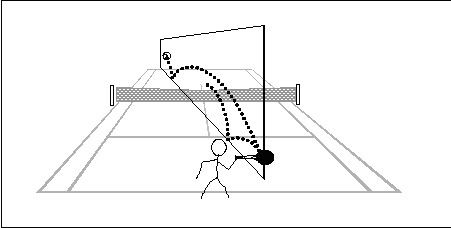
The diagram shows the orientation of the racket at impact with a service
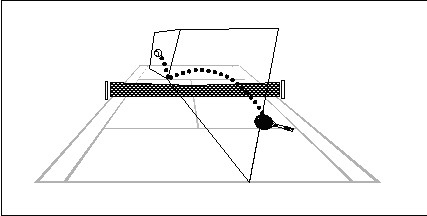
8. String tension
The strings have a trampoline-effect on the ball. The looser the tension of the strings, the more the trampoline-effect plays a role, and the faster the ball will travel, which is not always desirable. With looser tension you easily hit the ball out at the back. With tighter string tension you can convert more topspin to the ball with less chance of hitting it out at the back.
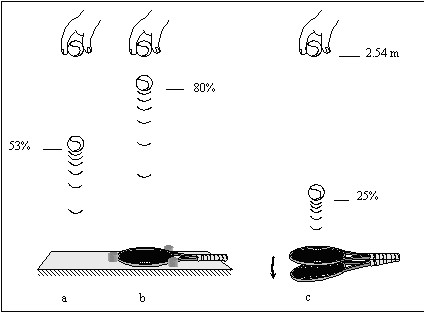
A new ball will bounce to about 53% of the height on a solid floor if it is dropped from 2.54 m (the ball will reach a speed of 25 km/h). If it is bounced from a clamped racket it will bounce to about 80% and on a racket held loosely to 25%. Older balls with less pressure will bounce lower in a. With higher tension in the strings, the ball will bounce lower in b.
With a heavier racket, the ball will bounce higher in c. If the ball is dropped from a higher point, all these percentages will drop. For instance: if the ball reaches a speed of 90 km/h on contact, the percentage in c will be about 16%.
The diagram below shows the deformations of a tennis ball when it hits the court.
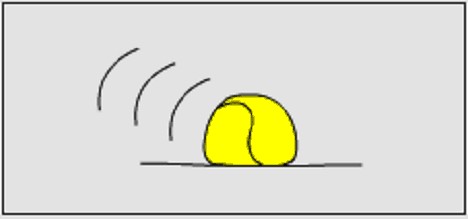
9. Altitude
At sea-level the air is denser and the ball looses speed faster as at higher altitudes. Also a ball with topspin will dip faster. The diagram shows the tracts of a tennis ball with (a) topspin (b) without spin at sea level, and (c) without spin at high altitude.
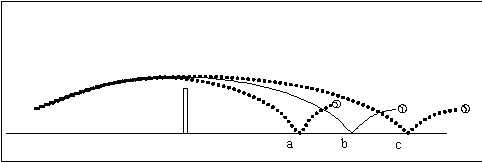
10. Surface of court.
The diagram below shows the traject of the ball after it has bounced from:
(a) a rough surface like a clay court. The ball bounces high, has lots of topspin and looses much of its speed.
(b) an all-weather surface
(c) a very smooth surface. The ball gathers very little topspin and comes through very fast.

